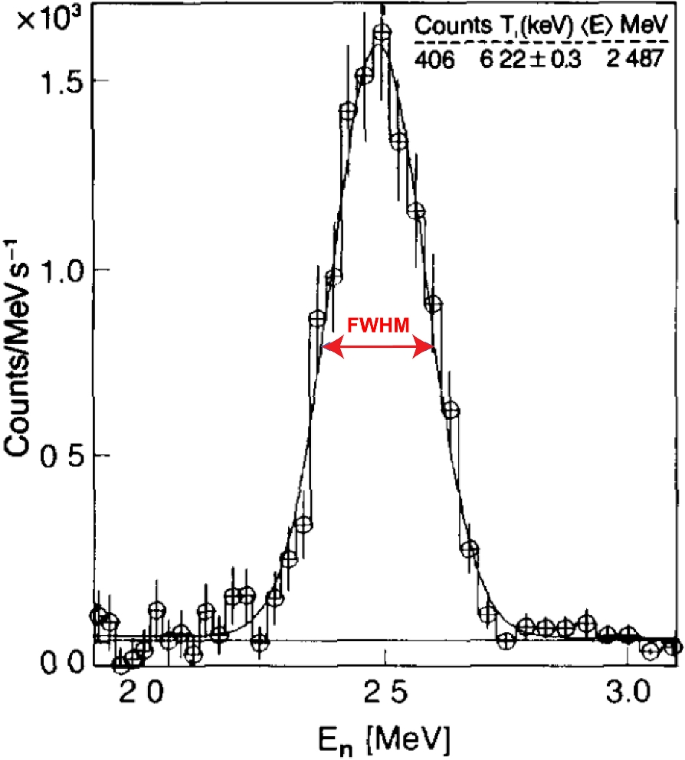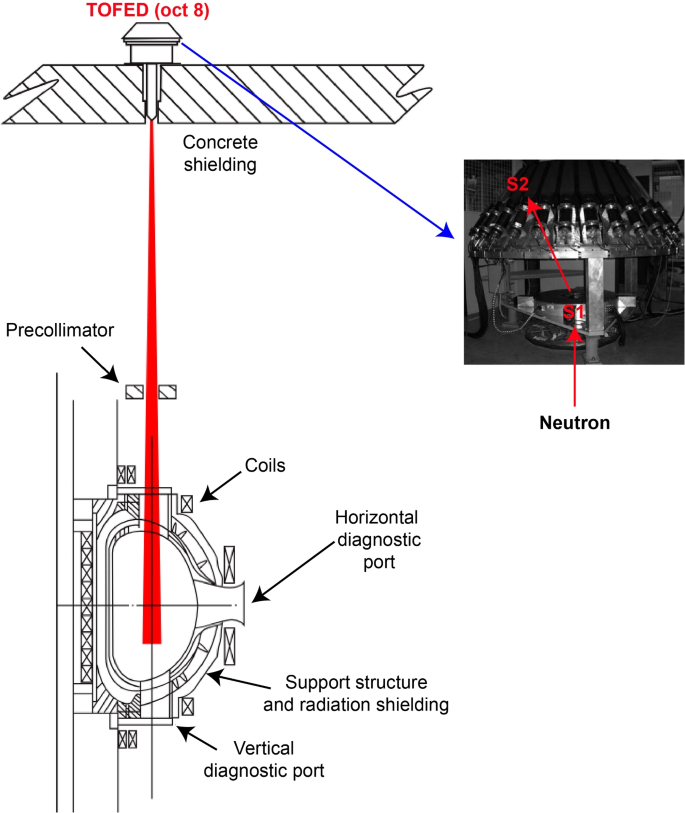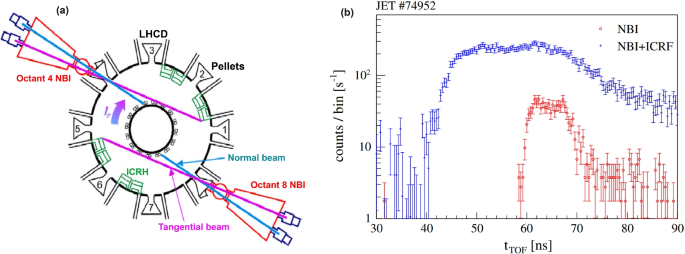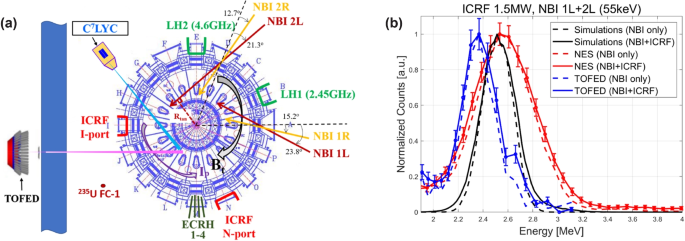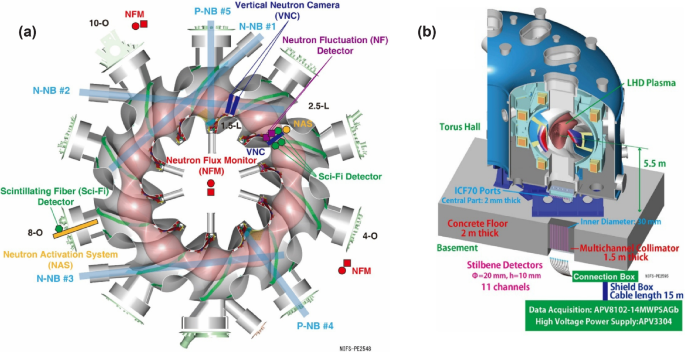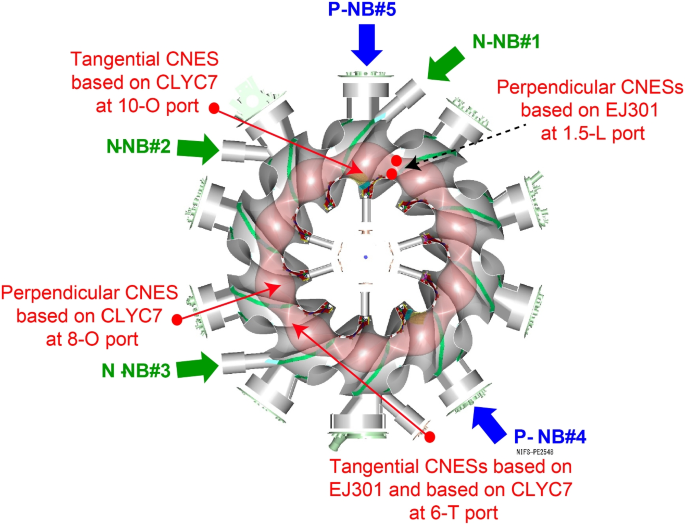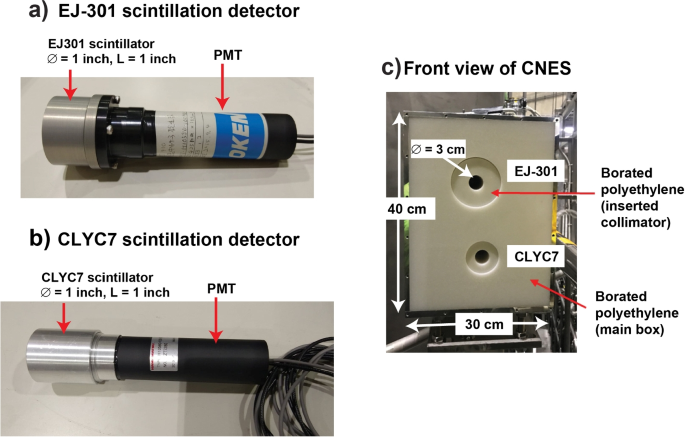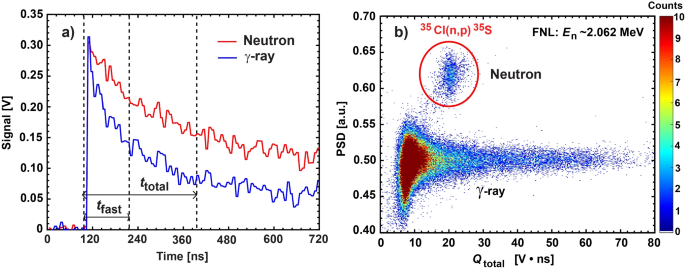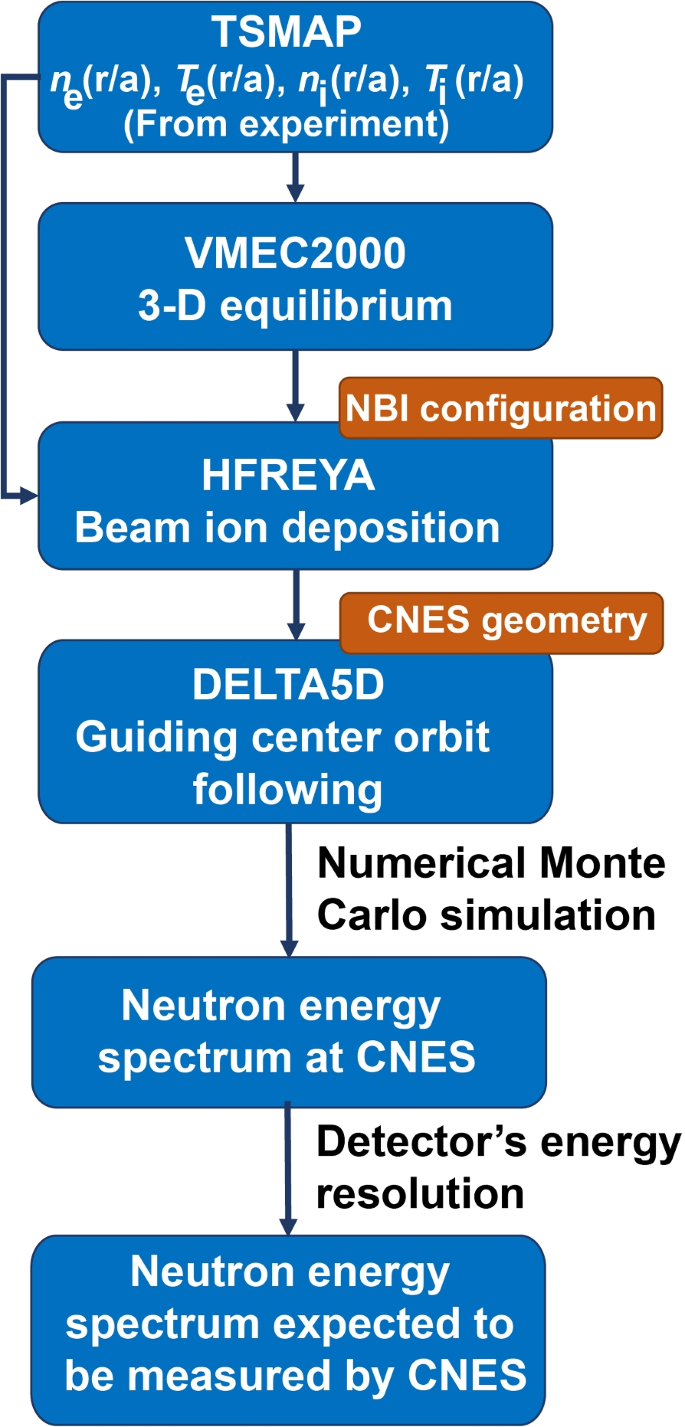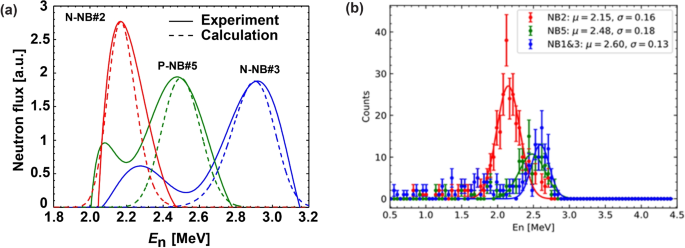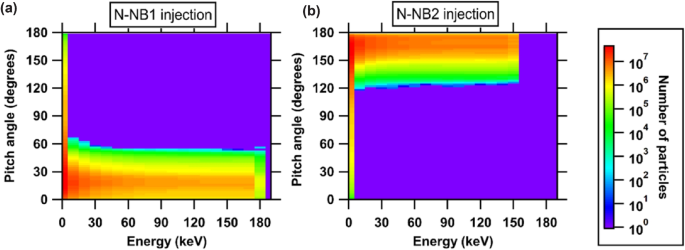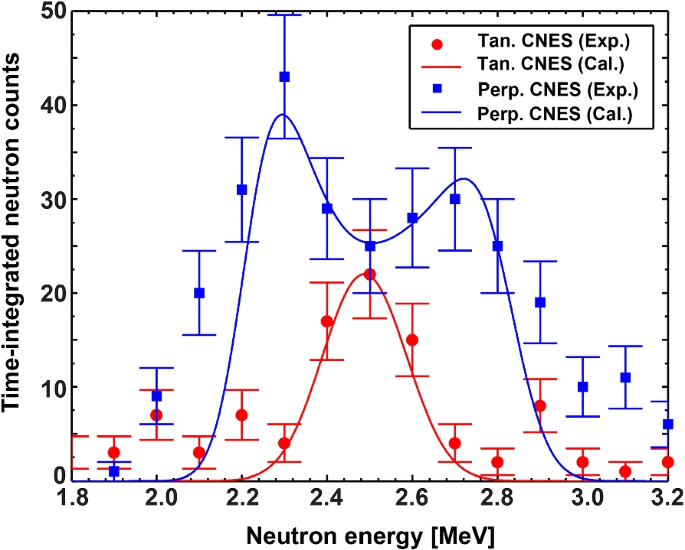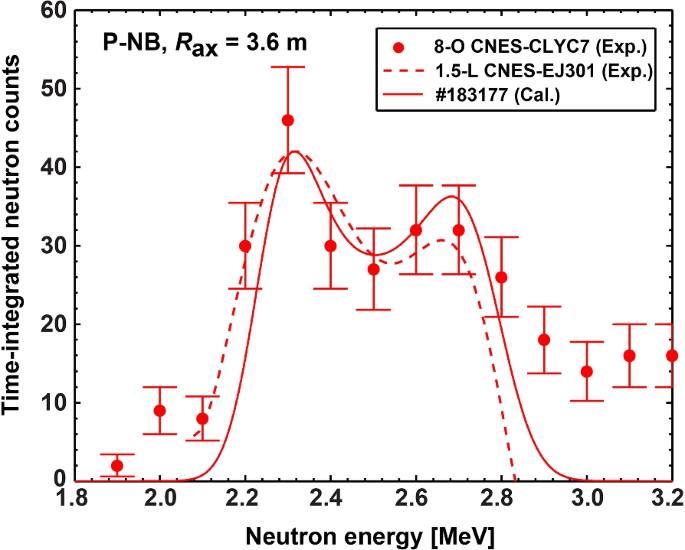1 Introduction
Fusion is the phenomenon where two light nuclei combine, releasing energy. This released energy can subsequently be utilized as heat for future power generation stations. Fusion processes naturally take place on the Sun and other stars. Fusion reactions occur at temperatures surpassing hundreds of millions of degrees Kelvin, equating to an average particle kinetic energy of roughly 10 keV. At these extremely high temperatures, matter takes the form of plasma, with atoms completely ionized. On Earth, research into controlled fusion reactions is achieved using magnetic confinement fusion devices such as the tokamak and stellarator or helical device. There are several fusion reactions that occur on Earth, including:
In current magnetic confinement fusion devices, achieving plasma ion temperatures of approximately 10–20 keV requires auxiliary heating. Nowadays, plasmas in magnetic confinement fusion devices are primarily heated by auxiliary heating systems such as neutral beam injection (NBI) and ion cyclotron range of frequencies (ICRF) waves. NBI and ICRF wave heating systems serve as the main sources of fast deuterons (referred to as fast ions), which imprint their characteristics on the emitted 2.45 MeV neutrons from deuterium-deuterium (D-D) reactions and/or the emitted 14.1 MeV neutrons from deuterium-tritium (D-T) reactions (see Eqs. 1–3). In plasma fusion, the comprehension of fast ion physics is critical for achieving high-performance plasmas and progressing towards the development of fusion power reactors [1]. Furthermore, a primary focus in fast ion confinement research is to understand the transport of fast ions caused by magnetohydrodynamic (MHD) instabilities induced by these ions [2]. This is because the reactor plasma’s self-sustaining state relies on self-heating from high-energy alpha particles produced by fusion reaction. The behavior of confined fast ions in fusion plasma has been effectively explored through various fast ion diagnostic techniques [3]. Among the most widely used diagnostics for investigating fast ion confinement are fast-ion D-alpha spectroscopy (FIDA) [4, 5] and neutral particle analyzers (NPA) [6, 7]. One of the most effective and straightforward ways to study fast ion physics in magnetic confinement fusion devices is through neutron diagnostics. Neutrons, as uncharged particles, can readily escape the magnetic field confinement, transmitting information about the fast ions. The measurement of neutrons provides insights into energetic particle physics, fast ion dynamics, and MHD instability, while also offering valuable information on fusion power and reaction rates [8]. Therefore, measuring neutron emissions from D-D and/or D-T plasmas in magnetic confinement fusion devices can offer valuable insights into fast ion behavior [9, 10]. Various neutron measurement method and techniques have been utilized in magnetic confinement fusion devices [11, 12]. Among these, the neutron emission spectrometer (NES) provides highly efficient and powerful diagnostics for studying fast ion behavior [13, 14]. Various fusion information is provided using the NES system, such as fuel ion speed distribution through the measurement of the spectral linewidth of fusion products in D-D, D-T, and 3He-D plasmas [15], fuel ion densities in D-T plasmas [16, 17], and determination of deuterium density profiles [18]. Several techniques successfully used in the NES system include time-of-flight, magnetic proton recoil, and compact neutron detectors. This paper focuses on general neutron measurements in magnetic confinement fusion devices and specifically on the application of compact neutron spectroscopy, particularly in studying NBI heated deuterium plasma in the Large Helical Device (LHD). The structure of this paper is as follows. Section 2 reviewed the different techniques for neutron measurement in magnetic confinement fusion devices. Section 3 provides a detailed discussion of the neutron emission spectrometer. Section 4 introduces the neutron measurement techniques used in the LHD. Section 5 presents the D-D neutron emission spectrometry in NBI heated plasmas in the LHD, measured using the compact neutron emission spectrometer (CNES). Finally, Section 6 provides a summary of the paper.
2 Neutron measurement in magnetic confinement fusion devices
In magnetic confinement fusion devices, neutron measurement techniques can be classified into three main groups. The first group of neutron diagnostic techniques is to determine the properties of the neutron source strength. There are several neutron diagnostics used for measuring neutron source strength. The first diagnostic comprises neutron flux monitors with time resolution, which measure the instantaneous neutron emission strength without providing information on energy and phase-space. This method involves counting the neutrons emitted by the plasma. Rapid signal fluctuations may be associated with MHD effects, offering insight into the efficiency of various heating schemes. Such methods include the use of BF3 or 3He proportional counters or 235U fission chambers, as implemented in TFTR [19, 20], JT-60U [21, 22], JET [23], and LHD [24, 25]. The other diagnostic utilized in magnetic confinement fusion devices to observe neutron source strength is the neutron activation system (NAS). The NAS measures the time-integrated neutron yields. By utilizing different types of activation foils with different energy thresholds, the NAS can perform measurements at different energy, 2.45 MeV D-D neutrons and 14.1 MeV D-T neutrons. The NAS system was successfully used in the TFTR [26, 27] and in JET [28, 29] to detect 2.45 MeV and 14.1 MeV neutrons. The measurement of 14.1 MeV neutrons was utilized for studying the burnup of fusion product tritons in JET [30]. Later, triton burnup measurements were successfully investigated using the NAS system in TFTR [31], ASDEX Upgrade [32], JT-60U [33], KSTAR [34], and LHD [35].
The second group of neutron diagnostic techniques is to determine the neutron emission profile. A crucial and highly efficient diagnostic used in fusion devices to provide time and spatially resolved neutron emission profile is the collimated neutron flux monitor, often referred to as the neutron camera. Neutron cameras have been instrumental in tokamak experiments, providing insights into the transport behaviors of energetic particles. For instance, at TFTR, a neutron camera with parallel collimators installed in the basement enabled the capture of neutron emission profiles with both time and spatial resolution during high-frequency MHD activity [36, 37]. Subsequently, fan-shaped horizontal and vertical neutron cameras were installed at JET [38, 39], allowing for the analysis of poloidal neutron emissivity distribution using tomographic reconstruction methods [40]. Additionally, the JT-60U incorporated a vertically inclined multichannel collimator [41, 42] to observe energetic ion transport during NBI heated plasma [43]. The vertical neutron camera were successful installed [44] and use for the fast ion confinement study in the LHD [45]. Plans for the future include the installation of horizontal and vertical neutron cameras at ITER, modeled after the neutron camera system at JET [46, 47]. The valuable insights obtained from neutron camera observations regarding energetic particle physics will play a pivotal role in achieving burning plasma in ITER.
The third group of neutron diagnostic techniques is to determine the neutron energy. Among these diagnostics, the NES stands out as a particularly notable and powerful tool for measuring neutron energy spectra [14]. Neutron spectroscopy in thermonuclear fusion has been extensively used to examine the fuel ion temperature by analyzing the Maxwellian distribution of neutron energies emitted from Maxwellian plasmas [48]. In the modern era, with the intense NBI heating of deuterium plasma in fusion devices, the role of neutron spectroscopy has evolved. During the NBI heating phase, the neutron spectrum deviates from a Maxwellian distribution, resulting in a Doppler shift in neutron energy that provides critical information on the energy distribution of fast ions generated in NBI heated fusion plasmas [49, 50]. The Doppler broadening effect from ion speed distribution on the 2.5 MeV neutron spectrum using Monte Carlo simulation has been discussed [51]. The anisotropy in fast ion velocities contributes to the formation of D-D [52, 53] and D-T neutron energy spectra [54], highlighting the significance of understanding energetic particle behavior in fusion reactions.
However, since neutrons are uncharged particles, their detection relies on nuclear reactions. Fundamental neutron detection principles used in magnetic confinement fusion devices can be summarized as follows:
-
One fundamental neutron detection principle involves nuclear elastic scattering, expressed as X(n,n’)X’, with X’ indicating the recoiling nuclear particle. In the case of neutrons, this results in the recoil proton. Several neutron detectors utilize this method, including organic scintillation detectors, thin-foil proton recoil detectors, and time-of-flight detectors.
-
Another useful nuclear reaction for neutron detection is nuclear inelastic scattering, expressed as X(n,n)X*, where X* denotes the unstable decay radiation. The diagnostic systems utilizing this method is neutron activation foils.
-
In neutron measurement, another valuable type of nuclear reaction is charged particle production, in which the reactions result in two or more charged products in the final state, expressed as X(n,y)Z, where y denotes charged particles such as protons (p), deuterons (d), alpha particles (\(\alpha\)), etc., which are useful for neutron measurement. Several neutron detectors utilize this method, including diamond semiconductor detectors, 3He tubes, Li-glass scintillators, and CLYC scintillators.
-
One common use in magnetic confinement fusion devices is the fission reaction, expressed as X(n,xn)Y*, Z*, where Y* and Z* represent heavy charged fission fragments and x is the number of produced neutrons. The diagnostic systems utilizing this method are fission chambers.
In fusion research, neutron measurements are often conducted in environments with both neutrons and \(\gamma\)-ray. Many detectors are sensitive to both types of radiation, making it necessary to employ n/\(\gamma\) pulse shape discrimination techniques. Pulse shape discrimination is a signal processing technique that distinguishes neutrons from \(\gamma\)-rays by analyzing the shape of radiation pulses. Several methods exist for pulse shape discrimination, such as the charge comparison method [55, 56], rise time discrimination [57], and the zero-crossing method [58].
3 Neutron emission spectrometer
The NES system primarily offers detailed information, such as the effective temperature of fast ions and the fractional contributions of neutron emissions from fuel ions in mixed D-D and D-T plasmas. It has been established for a long time that neutron measurements can be used to study the fuel ion temperature through the Maxwellian distribution in the energy of neutrons emitted from Maxwellian plasmas [59, 60]. After strong NBI heating began, the role of neutron spectroscopy has changed since neutron spectrum is no longer Maxwellian in the NBI heating phase. Neutron spectroscopy provides insights into the velocity distribution of beam ions, contributing to a deeper understanding of plasma behavior under various heating conditions [61, 62].
3.1 Derivation of fast ion temperatures
In thermonuclear fusion, neutron spectroscopy plays a critical role by facilitating the differentiation between thermal and beam-plasma contributions within the plasma. This technique not only allows for the separation of these distinct components but also offers an accurate and direct measurement of the fuel ion temperature [63]. The first determination of fuel ion temperature from neutron spectroscopy measurements was performed as shown in Ref. [64]. The shift in neutron energy due to ion temperature is negligible, but the Doppler broadening can be used to determine the fuel ion temperature. Neutron spectroscopy has been conducted to determine the bulk-ion plasma temperature in various devices, including TFTR [65, 66], PLT [61], JET [67, 68], ASDEX [69], and ASDEX Upgrade [70]. The energy spectrum function (\(f(E_n)\)) of thermonuclear neutrons is approximately Gaussian in shape and can be expressed as [11]:
where \(E_n\) is the neutron energy and W is defined as:
In this expression, \(m_n\) represents the neutron mass, \(\langle E_n \rangle\) is the average neutron energy, \(T_i\) is the ion temperature, and \(m_\alpha\) denotes the alpha particle mass. Consequently, the average neutron energy can be expressed as:
where \(\langle V^2 \rangle\) is the mean square velocity of the reacting ions, Q is the reaction energy, and K represents the relative kinetic energy of the colliding particles. The fuel ion temperature can be inferred from the neutron energy spectra by analyzing the full width at half maximum (FWHM) of the neutron energy distribution. This approach allows for a non-intrusive method to gauge ion temperatures within the plasma based on the Doppler broadening of neutron emissions. For D-D fusion reactions, the relationship between the FWHM of the neutron spectrum and \(T_i\) is expressed as:
For D-T fusion reactions, which produce higher-energy neutrons, the FWHM is given by:
These expressions underscore the dependency of neutron emission broadening on fuel ion temperature, enabling precise measurements of \(T_i\) in fusion plasmas. Figure 1 shows the neutron energy spectrum measured at JET using time-of-flight techniques [71]. The data were collected during an deuterium plasma experimental phase involving 5 MW of ICRF wave heating with 3He minority ions, resulting in significant neutron emissions. The FWHM of the spectrum indicated an ion temperature of 6.2 keV, suggesting efficient energy transfer to the plasma ions. This measured spectrum provides valuable insights into the neutron energy distribution under these heating conditions, aiding in the analysis of fast ion temperature.
The neutron energy spectrum measured during 5 MW of ICRF (3He minority) wave heating utilizing time-of-flight at JET. The figure is taken from Ref. [71]
3.2 Derivation of fast ion velocity distribution
In the intense NBI heating and ICRF wave heated plasma, neutrons exhibit significant Doppler shifts in their energy, altering the traditional role of neutron spectroscopy. Instead of solely measuring ion temperatures, neutron spectroscopy is now instrumental in determining the velocity distribution of fast ions, providing crucial insights into fast ion behavior in these high-energy plasmas [61, 62]. The principle of neutron spectrometry using different line-of-sight orientations, both clockwise and counter-clockwise, for studying the plasma toroidal rotation velocity during the NBI heated plasma was discussed in Ref. [72]. A few neutron measurements in non-thermonuclear plasma heated by NBI and ICRF waves, exhibiting Doppler shifts, have been conducted at PLT [73], JET [74, 75], MAST [76], and EAST [77]. The effective neutron spectroscopy techniques employed thus far include the NES, which utilizes methods such as time-of-flight, the magnetic proton recoil spectrometer, and the compact neutron emission spectrometer (CNES). Figure 2a and b illustrate the kinematics of a fusion reaction between a beam deuteron and a fuel deuteron, resulting in the emission of product particles, specifically 3He and a neutron, shown in the center-of-mass frame and the laboratory frame, respectively. Considering momentum conservation of the reactants in the center-of-mass frame, the velocity of the 3He particle (\(\vec {v}_{ ^3He}\)) is associated with the velocity of the neutron (\(\vec {v}_n\)) as [78]:
where \(m_n\) represents the mass of the neutron and \(m_{ ^3He}\) denotes the mass of 3He. Consequently, the neutron speed (\(v_n\)) in the center-of-mass frame, based on the energy and mass parameters of the reaction, can be derived using Eq. 9 along with energy conservation, and is given by:
Kinematics of a fusion reaction emitting a neutron a in the center-of-mass frame and b in the laboratory frame. The figures are taken from Ref. [78]
In this equation, Q represents the total energy release of 3.27 MeV from the D-D reaction; K is the kinetic energy of the reacting particles in the center-of-mass frame. The kinetic energy K can be expressed as:
where \(m_{D1}\) and \(m_{D2}\) are the masses of the deuterons involved in the reaction, and v denotes the average speed of the deuterons. This framework allows for the calculation of neutron speed by considering the total reaction energy and the center-of-mass kinetic energy contributions. Consequently, the neutron velocity in the lab frame can be expressed as the sum of \(\vec {v}_n\)in the center-of-mass frame and the center-of-mass velocity \(\vec {v}_{COM}\). The kinetic energy of the neutron in the lab frame can then be calculated as:
where \(\theta\) denotes the angle between \(\vec {v}_{COM}\) and \(\vec {v}_n\). By substituting the value from Eq. 10 into Eq. 12, the neutron energy can be expressed as follows [60]:
In a thermal D-D plasma, the neutron energy spectrum \(E_n\) generally exhibits a Gaussian profile centered around 2.45 MeV, typical of fusion neutrons generated under thermal equilibrium. The relatively narrow distribution arises from the thermal motion of deuterons in a Maxwellian velocity distribution. However, in plasmas heated by NBI, where the velocity of beam-injected deuterons exceeds that of thermal fuel deuterons, the neutron energy spectrum is notably modified. The interaction between energetic, non-thermal beam deuterons and thermal fuel ions introduces significant broadening and shifting in the neutron energy spectrum. This altered distribution includes components at both higher and lower energies relative to the thermal peak, reflecting the Doppler shifts resulting from the fast ion velocity along the line-of-sight of measurement. In this scenario, if \(\vec {v}_{COM}\) is aligned with \(\vec {v}_n\) (i.e., \(\theta = 0^\circ\)), \(E_n\) attains its maximum value, indicating an upward shift in the energy of D-D neutrons. Conversely, when \(\vec {v}_{COM}\) is opposite to \(\vec {v}_n\) (i.e., \(\theta = 180^\circ\)), \(E_n\) reaches its minimum value, reflecting a downward shift in D-D neutron energy. When \(\vec {v}_{COM}\) is perpendicular to \(\vec {v}_n\) (i.e., \(\theta = 90^\circ\)), the third term in Eq. 13 becomes negligible, having minimal effect on the D-D neutron energy.
3.3 Neutron emission spectrometer techniques
3.3.1 Time-of-flight spectrometer
The neutron time-of-flight technique provides high efficiency and powerful diagnostics [79]. This method operates by measuring the time it takes for neutrons to travel between the first detector (\(S_1\)) and the second detector (\(S_2\)), providing valuable information on neutron energy and emission characteristics. Positioned on a constant time-of-flight sphere with a specified radius L, detector \(S_1\) (serving as the ’start’ signal) is placed within a collimated neutron beam, while detector \(S_2\) (acting as the ’stop’ signal) is positioned to ensure a uniform time-of-flight (\(t_{tof}\)) for neutrons passing from \(S_1\) to \(S_2\). The time-of-flight between these two detectors, which provides a direct measurement of neutron energy, is calculated as:
where \(m_n\) is the mass of the incoming neutrons, \(E_n\) is neutron energy, and L is the distance between the detectors. This equation illustrates the relationship between the neutron’s time-of-flight \(t_{tof}\) and its energy \(E_n\), providing a basis for calculating neutron energies from time-of-flight measurements. Plastic scintillators are predominantly utilized in time-of-flight techniques. The effectiveness in terms of count rate of high-resolution neutron spectrometers employing the time-of-flight technique for fusion neutrons has been evaluated [80,81,82]. A neutron time-of-flight spectrometer has been developed and tested for JET deuterium plasma heated by NBI [83, 84]. The efficiency, resolution, and response functions of these new neutron time-of-flight spectrometers were evaluated using Monte Carlo simulations [85]. Optimization of energy resolution for a two-detector time-of-flight spectrometer for D-D neutrons was also investigated [86]. At JET, a conceptually defined and developed time-of-flight spectrometer for optimized rate (TOFOR) has been employed to measure 2.45 MeV D-D neutrons [87]. TOFOR is installed on the laboratory roof [88,89,90] as shown in Fig. 3 [90]. The modeling and TOFOR measurements of scattered neutrons at JET have been explored [91]. Figure 4a shows the geometry of the NBI injection system and the location of the ICRF wave heating in the JET, as seen from the top [92]. The NBI injects fast ions almost perpendicular to the magnetic field. TOFOR was successfully employed for neutron spectroscopy in NBI heated plasma [93] and for an experiment involving ICRF-acceleration of helium beam ions [94]. During the experiment in JET, when the plasma was heated by 3 MW of 110 keV NBI in plasma discharge #74952, the double-humped shape spectrum was observed by the TOFOR (see Fig. 4b). Additionally, ICRF wave heating was applied at 52 MHz, aligning the third harmonic deuterium resonance with the magnetic axis. This configuration contributed to the acceleration of fast ions to energies reaching approximately 2–3 MeV. The result shows the peak broadened on the high-energy (low time-of-flight) side due to the fast ion acceleration process driven by the ICRF wave heating. Recently, the development and implementation of a fully digital data acquisition (DAQ) system upgrade for the TOFOR spectrometer at JET, known as TOFu, have been completed. This upgrade replaces the original system to enhance the performance of fast neutron spectrum detection and analysis. One of the key advancements of the TOFu system is its ability to conduct correlated time and pulse height analysis on acquired data, alongside an improved signal-to-noise ratio in D-D and D-T neutron measurements, capabilities that were not achievable with the previous DAQ system. These enhancements provide increased accuracy and resolution in neutron event analysis, marking a significant advancement in time-of-flight neutron spectrometry [95].
The TOFOR at JET. The figure is taken from Ref. [90]
Further advancements in the time-of-flight technique have been developed and employed in other magnetic confinement fusion devices. A 2.45 MeV neutron time-of-flight spectrometer designed for use in JT-60U has been developed [96]. Neutron-time-of-flight (nTOF) systems based on CVD diamond detectors and scintillator detectors have been developed and deployed in various locations within the National Ignition Facility (NIF) [97]. The recently installed time-of-flight neutron spectrometer, named Time-of-Flight Enhanced Diagnostics (TOFED), has been set up in the neutron diagnostic laboratory located outside the EAST experimental hall [98, 99]. The TOFED was designed with \(S_2\) split into two rings [100]. The line-of-sight for TOFED in EAST is established by a collimator that penetrates a 150-cm biological shielding wall, significantly attenuating background neutrons and thereby enabling accurate neutron spectral measurements. Additionally, the design of a magnetic shielding system [101] and a radiation shielding system [102] has been implemented to optimize TOFED performance at EAST. The first results of the TOFED in the NBI heated plasma in EAST have been evaluated [103]. Since 2019, TOFED, utilizing a design identical to that employed at EAST, has been evaluated and adapted for the measurement of 14 MeV D-T neutrons in the LHD [104]. Additionally, a radiation shielding design for TOFED at LHD has been modeled to enhance measurement accuracy [105]. Given the high efficiency of the time-of-flight technique in current magnetic confinement fusion devices, a conceptual study of a BackTOF neutron spectrometer for measuring fuel ion ratios at ITER has been explored, yielding valuable insights for enhancing diagnostic capabilities in future applications [106, 107].
3.3.2 Magnetic proton recoil spectrometer
Another effective and powerful neutron spectroscopy technique is the magnetic proton recoil spectrometer. The first magnetic proton recoil spectrometer for measuring fusion neutron spectra was developed in JET [108, 109]. The initial application, particularly focusing on observing the \(\alpha\) knock-on effect in neutron emission spectroscopy, was established [110]. Subsequently, an upgraded version of the magnetic proton recoil neutron spectrometer (MPRu) was developed and characterized in 2003 for 14 MeV D-T neutron measurements at JET [111,112,113]. The new control and monitoring system is being utilized for the JET neutron spectrometer, including both the TOFOR and MPRu fusion systems [114]. Subsequently, the magnetic recoil spectrometer (MRS) has been deployed in various locations around the NIF target chamber, enabling measurements of neutron yield and ion temperature [97].
The knowledge gained from advanced NES diagnostics at JET, including the time-of-flight technique and the magnetic proton recoil spectrometer, offers valuable insights for developing high-performance neutron diagnostics for ITER [115, 116]. These techniques demonstrate exceptional performance in neutron energy resolution and detection capabilities. However, the large size and complexity of the magnetic proton recoil spectrometer make it impractical for installation on ITER. To reduce system complexity while meeting the requirements for time-resolved neutron energy spectra measurements in both D-D and D-T experiments on ITER, a high-resolution neutron spectrometer system has been proposed. This system includes four neutron spectrometers: a thin-foil proton recoil spectrometer, a neutron diamond detector, a back-scattering time-of-flight system, and a forward time-of-flight system [117]. This integrated approach is designed to offer the precision and adaptability essential for comprehensive neutron spectrometry in the ITER environment, providing critical information such as fuel ion rate and fuel ion temperature.
3.3.3 Compact neutron emission spectrometer
To eliminate with the huge size and complicated system, one of the most powerful NES diagnostic is offer by the CNES. The system is base on single detector with the data acquisition system. The common detector used in the CNES system is offer by conventional organic liquid scintillator detector [118], i.e., NE-213, EJ-301, due to it high capability on neutron and \(\gamma\)-rays discrimination [119,120,121], high efficiency. In liquid scintillators, neutron detection primarily depends on neutron-proton elastic scattering, in which only the energy of the recoiled proton is detected. When a neutron collides with a proton in the scintillator medium, energy is transferred to the proton based on the neutron’s incoming energy and the angle of scattering. The kinetic energy of the recoiled proton can vary from zero (for forward or backward scattering at specific angles) to the full energy of the incident neutron (in cases of head-on collisions). Unfolding techniques are necessary to obtain the neutron energy spectrum. Initially, simple methods like the derivative unfolding technique were utilized [122, 123]. Later, more sophisticated inversion methods such as MAXED [124, 125], Bayesian parameter estimation methods [126], and GRAVEL [127] became widely used. The sensitivity of parameters in the unfolding code has been assessed [128].
A conventional NE-213 scintillation detector was initially utilized in a mixed field of fast neutrons and \(\gamma\)-rays at TFR [129]. Subsequently, at JET, a CNES based on the NE-213 scintillation detector was successfully employed for measuring D-D and D-T neutron spectra [130]. The detectors were installed in the laboratory on the roof, providing a vertical line-of-sight. The ion temperature of the JET plasma was inferred using the CNES based on NE-213 scintillation detector during ohmic plasma experiments [131]. Following this, the NE-213 detector was employed within a compact spectrometer at the Frascati Tokamak Upgrade (FTU) to measure D-D and D-T neutron emissions [132]. Subsequently, the CNES system was enhanced with the incorporation of BC-501A liquid scintillation material. In 2008, this upgraded CNES, equipped with a BC-501A scintillation detector, was installed at AUG for the measurement of D-D and D-T neutron emissions [133]. The detector is positioned outside the experimental hall and uses a wall collimator with a pre-collimator. The response function matrix of this detector has been characterized for D-D and D-T neutron measurements [134]. In 2010, a new compact spectrometer featuring the BC-501A liquid scintillation detector was subsequently installed at JET, further enhancing the facility’s neutron measurement capabilities and contributing to high-resolution diagnostic efforts in fusion plasma studies [135]. Subsequently, a CNES equipped with an EJ-301 scintillation detector was implemented in various magnetic confinement fusion devices, including EAST [136] and LHD [137, 138]. At EAST, the CNES system based on the EJ-301 detector enabled researchers to measure the velocity distribution function of fast ions effectively during lower hybrid wave (LHW) injection and ICRF wave heating, providing valuable insights into ion dynamics under these heating conditions [139]. This capability enabled a detailed examination of fast ion dynamics and energy distribution under different heating scenarios, allowing insights into the effects of LHW and ICRF on ion acceleration and confinement. Such measurements are essential for optimizing plasma heating and fast ion behavior, which are critical factors in enhancing plasma performance and achieving steady-state operation in EAST. Detailed information regarding the CNES system based on the EJ-301 scintillation detector at LHD is presented in the following section.
Unlike liquid scintillators, the recently developed inorganic Cs2LiYCl6 crystal scintillation detector, enriched with 7Li (CLYC7), possesses a unique ability to directly detect fast neutrons from D-D fusion plasma via the 35Cl(n,p)35S reaction [140]. This capability removes the need for unfolding methods commonly required with other detectors, thereby streamlining the measurement process for CNES. The CLYC7 scintillation detector is specifically designed for detecting both \(\gamma\)-rays and fast neutrons, providing high detection efficiency, superior energy resolution, and strong pulse shape discrimination capabilities [141,142,143,144]. The effectiveness of CLYC7 in mixed radiation fields, where fast neutrons and \(\gamma\)-rays coexist, is due to its unique composition, which includes 7Li and 35Cl atoms. This composition enables CLYC7 to interact efficiently with neutrons and accurately measure their properties, making it highly valuable for neutron spectroscopy in fusion research [140]. The detection of thermal neutrons by CLYC7 primarily relies on the 6Li(n,\(\alpha\))T reaction [145, 146]. Due to its 99% 7Li enrichment, CLYC7 exhibits significantly reduced sensitivity to thermal neutrons. Instead, the detector responds predominantly to fast neutrons via the 35Cl(n,p)35S and 35Cl(n,\(\alpha\))32P reactions, enabling its effective use in fast neutron spectroscopy [147, 148]. Recently, to address issues associated with unwanted unfolding techniques, the CLYC7 scintillation detector has been integrated into the CNES system at EAST [149, 150] and LHD [151, 152]. This implementation leverages CLYC7’s capabilities to improve neutron spectral measurements and enhance diagnostic accuracy in these fusion devices. Figure 5a shows the top view of the EAST tokamak, including the configurations of NBI and ICRF wave heating and the locations of CNES based on CLYC7 scintillation detector and TOFED spectrometer. The NBI injection was set to different energies between 40 keV and 70 keV, providing NBI power of 0.4 MW and 1.45 MW. Figure 5b shows the results obtained by CNES based on CLYC7 scintillation detector and TOFED spectrometer where the beam energy is set to 55 keV. In ICRF wave and NBI heated deuterium plasma, the fast ions have been accelerated to higher energies. Broadening on the high-energy side up to 3.2 MeV has been observed. Detailed information regarding the CNES system based on the CLYC7 scintillation detector at LHD is presented in the following section.
a A top view of the EAST tokamak, showing the configurations of ICRF, ECRH, LH, and NBI heating systems, as well as the positions of the CNES based on CLYC7 scintillation detector and TOFED neutron diagnostics. b A comparison of the neutron energy distribution between the CNES based on the CLYC7 scintillation detector and the TOFED system conducted during NBI and/or ICRF wave heated plasma in EAST. The figures are taken from Ref. [149]
4 Neutron measurement in the Large Helical Device
A comprehensive research investigation has been conducted within the framework of the Large Helical Device (LHD) to explore the transport dynamics of fast ions influenced by MHD instabilities induced by these ions in plasmas heated by NBI [153]. In hydrogen plasma experiments, the retention of fast ions generated by NBI and ICRF wave heating was examined [154]. This investigation employed a comprehensive array of fast ion diagnostic tools [155], enabling detailed measurements of ion behavior, confinement, and losses within the plasma. These diagnostics provided valuable data on the effectiveness of heating methods and the stability of fast ion populations under different experimental conditions, contributing to a deeper understanding of fast ion dynamics in fusion plasmas. Research into the transport and loss of fast ions associated with toroidal Alfvén eigenmodes has been conducted using a NPA [156] and a specialized detector for monitoring fast ion loss [157]. Comparisons between experimental results and numerical simulations have provided valuable insights into the mechanisms of fast ion transport and loss processes induced by toroidal Alfvén eigenmodes [158, 159]. However, the information available on fast ion confinement remains limited within both real and phase spaces, constraining a complete understanding of ion dynamics and interactions in these contexts. The study examined the confinement characteristics of helically trapped protons accelerated within ion cyclotron resonance heated plasma. This investigation employed a NPA based on diamond detectors [160], enabling precise measurements of proton behavior and confinement under these conditions. The neutron measurement in LHD deuterium plasma was planned since 2010 [161].
Initiating the deuterium plasma experiment within the LHD in March 2017 enabled the exploration of neutron measurements. LHD integrates three tangentially NBIs employing negative-ion sources (N-NBs) and two perpendicularly NBIs utilizing positive-ion sources (P-NBs), collectively supplying heating power of up to 35 MW. Neutrons are generated through fusion reactions, specifically D(D,n)3He, involving fast ions produced by beam ions and bulk ions. The maximum total neutron emission rate (\(S_n\)) in the LHD is projected to reach \(1.9 \times 10^{16}\) neutrons per second, a significant rate that reflects the high-energy fusion reactions occurring within the device [162]. To advance the study of these reactions and gain detailed insights into fast ion dynamics, a comprehensive neutron diagnostic system has been implemented at LHD. This system includes various advanced diagnostic tools, enabling precise measurement of neutron flux, neutron energy spectra, and spatial distribution of neutron emissions [163,164,165,166]. Energetic particle transport in the LHD has been intensively studied using a comprehensive set of neutron diagnostics [167,168,169]. These diagnostics enable detailed analysis of neutron emission profiles and fast ion behavior, providing critical insights into transport dynamics within the plasma. Figure 6a shows the arrangement of LHD, N-NBs, P-NBs, and neutron diagnostics in the LHD as presented in 2021 [163]. The neutron systems available in the LHD are listed in Table 1. The neutron flux monitor (NFM), also known as the 235U fission chamber, has been developed to measure total neutron emission rate for deuterium plasma operation [24, 25]. To measure 14.1 MeV D-T neutrons, the neutron activation system (NAS) [170] and the scintillating fiber (Sci-Fi) detector [171, 172] have been utilized. Based on the knowledge gained from using Sci-Fi detectors in the LHD, these detectors have been applied to perform high-time-resolution secondary D-T neutron measurements in KSTAR [173]. In addition, the neutron fluctuation (NF) detector was designed to observing the rapid change of neutron flux due to MHD instabilities in the LHD [174]. For the fast ion physics study, highly efficient vertical neutron cameras (VNC) have been designed for use on the LHD. Figure 6b shows the VNC#1 at 2.5-L LHD port [44]. VNC#1 provides essential information for studying the confinement properties of energetic ions in the LHD [45, 175, 176]. Subsequently, VNC#2 and VNC#3 were designed to achieve higher time-resolved neutron emission profile measurements during MHD activities [177], facilitating the visualization of poloidal structures associated with helically trapped fast ions produced by P-NB heating [178]. Extensive studies utilizing the VNCs have been carried out to examine the transport and loss mechanisms of fast ions induced by helically trapped fast ions in the LHD [175, 176, 179]. Despite extensive research on fast ion behavior in the LHD, direct measurements in both real and phase spaces remain limited. To address this gap, neutron spectroscopy has been effectively implemented using the NES system, particularly through the time-of-flight enhanced diagnostics (TOFED) [104, 105]. This setup enables detailed observation of fast ion dynamics in both spatial and momentum coordinates, enhancing the understanding of fast ion behavior and their interaction with the plasma environment in real and phase spaces.
a Arrangement of LHD, N-NBs, P-NBs, and neutron diagnostics in the LHD. b A schematic diagram of VNC#1. The figures are taken from Ref. [163]
Table 1 List of comprehensive neutron diagnostics in LHD
| System | Objects | Physics information |
|---|---|---|
| Neutron flux monitor (NFM) | Time-resolved total neutron emission rate | Fusion output and fusion gain, global confinement of beam ions |
| Neutron activation system (NAA) | Shot-integrated DD and DT neutron yield | Global confinement of beam ions, global confinement of 1 MeV tritons |
| Vertical neutron camera (VNC) | Time-resolved neutron emission profile | Deposition profile of beam ions, radial transport of beam ions |
| Scintillating fiber (Sci-Fi) detector | Time-resolved DT neutron emission rate | Global confinement of 1 MeV tritons |
| Neutron fluctuation (NF) detector | Neutron fluctuation | Global confinement of beam ions |
As discussed above, numerous neutron diagnostics have been deployed and operated in the LHD since the operation of deuterium plasma in 2017 [163]. However, it is worth noting that a CNES has been notably absent from these diagnostic systems. Since 2020, six CNESs have been deployed in various locations around the LHD [138, 152], ensuring comprehensive coverage and complementarity essential for measurements in N-NBs, P-NBs, and ICRF wave heated plasma (see Fig. 7). In 2020, two tangential CNESs, one based on EJ-301 scintillation detector and the other based on CLYC7 scintillation detector, with tangency radii of 3.6 m and 3.65 m, respectively, were installed at the 6-T LHD port. Figure 8a and b show the 1-inch diameter EJ-301 scintillation detector and the 1-inch diameter CLYC7 scintillation detector, respectively, used in these CNES system. Note that the same detector models were also used for the other CNESs in the LHD. The detectors were housed in a magnetic shield made of 1 cm thick SS400 steel. The outer layers of the setup featured a \(\gamma\)-ray shield made of 5-cm-thick lead, along with a neutron shield made from 10% borated polyethylene, measuring 30 cm in width, 60 cm in length, and 40 cm in height (see Fig. 8c). To enhance directivity, a collimator with a 3-cm inner diameter was positioned in front of each detector. In 2021, two perpendicular CNESs based on EJ-301 liquid scintillators were installed at the 1.5-L port of the LHD. These detectors were meticulously placed at radial distances of 3.725 m and 3.875 m, aligned with heavy concrete collimators measuring 150 cm in length and 5 cm in diameter, to optimize neutron detection. Positioned 7 m from the plasma mid-plane, the setup was designed to provide high precision in neutron flux measurements and improve spatial resolution in neutron diagnostics. In 2022, a tangential CNES based on CLYC7 with a tangency radius of 2.80 m was installed at the 10-O LHD port, while a perpendicular CNES based on CLYC7 was installed at the 8-O LHD port.
a The EJ-301 scintillation detector. b The CLYC7 scintillation detector. c The front view of the shielding box of the CNESs at 6-T LHD port. The figures are taken from Ref. [137]
As described above, two line-of-sight orientations are designed to observe fast ion behavior from different perspectives corresponding to various NBI injection configurations. A tangential CNES was specifically designed to detect the significant Doppler shift effect of neutron energy during high-energy N-NB injection. N-NB injects high-energy fast ions with an initial energy of approximately 180 keV. When these beam deuterons collide with thermal deuterons in the plasma, if the center-of-mass moves towards the tangential CNES, an upshift in neutron energy is expected. Conversely, if the center-of-mass moves away from the tangential CNES, a downshift in neutron energy is expected. However, during P-NB injection, when the center-of-mass moves perpendicular to the tangential CNES line-of-sight, no Doppler shift effect is anticipated. A perpendicular CNES was specifically designed to observe the behavior of helically trapped beam ions generated by P-NB injection and/or ICRF wave heated plasma. During P-NB injection, beam deuterons are introduced with a perpendicular velocity component \(v_{\perp } \gg v_{\parallel }\) and an initial energy of approximately 80 keV. When these beam deuterons collide with thermal deuterons in the plasma, if the center-of-mass moves towards the perpendicular CNES, an upshift in neutron energy is expected due to the Doppler effect. Conversely, if the center-of-mass moves away from the perpendicular CNES, a downshift in neutron energy is anticipated. However, during N-NB injection, when the center-of-mass moves perpendicular to the perpendicular CNES line-of-sight, no Doppler shift effect is expected, as the relative motion along the line-of-sight direction is minimized or absent. This setup allows for the observation and study of distinct plasma phenomena depending on the injection configuration and the resulting motion of fast ions relative to the CNES detectors.
Two types of detectors have been used in the CNES. The first type is the conventional EJ-301 scintillation detector, selected for its effective capabilities in discriminating between neutron and \(\gamma\)-ray pulses, high neutron detection efficiency, and ability to provide a fast decay time signal. Prior to deployment in the LHD, each EJ-301 scintillation detector underwent comprehensive characterization at the Fast Neutron Laboratory (FNL) at Tohoku University [180]. This characterization was conducted over a neutron energy range from 2 MeV to 5.55 MeV to assess detector response under varied neutron energies relevant to operational conditions. During these tests, the detectors’ pulse shape discrimination capabilities and linearity in response were thoroughly evaluated. All detectors demonstrated an energy resolution of approximately 6% at an incident neutron energy of 2.5 MeV, indicative of their high sensitivity and precision in fast neutron detection [180]. Figure 9a shows the waveform signal obtained by the EJ-301 scintillation detector, which has a decay time of approximately 60–70 ns. To discriminate between neutrons and \(\gamma\)-rays, the charge comparison method was employed, leveraging the different decay times of neutron and \(\gamma\)-ray pulses with the same amplitude. The neutron and \(\gamma\)-ray pulse shape discrimination (PSD) parameter is defined as:
where \(Q_{total}\) represents the total charge, obtained by integrating the induced waveform over a time interval \(t_{total}\) of 34 ns, and \(Q_{fast}\) represents the charge associated with the fast component of the waveform, determined by integrating over a time interval \(t_{fast}\) of 10 ns. Figure 9b illustrates the relationship between the PSD parameter and \(Q_{total}\) for neutrons with an incident energy of 5.55 MeV. It is evident that neutrons were effectively discriminated from \(\gamma\)-rays. The region-of-interest, determined by a PSD parameter above 0.13 and indicated by the red dashed line, was associated with the neutron signals. Note that neutron detection in the EJ-301 scintillation detector relied on neutron-proton elastic scattering. Only recoiled protons with energies (\(E_p\)) ranging from zero up to the neutron’s incident energy, depending on the scattering angle, could be detected by the EJ-301 scintillation detector, as shown by the black solid line in Fig. 9c. We employed the derivative unfolding technique [123] to extract the neutron energy spectrum from its recoil proton pulse height spectrum [137, 181]. Figure 9c shows an example of the unfolded neutron energy spectrum obtained for the incident neutron energy of 5.55 MeV. The CNES, based on the EJ-301 scintillation detector, is capable of operating across a wide range of neutron emission rates due to the fast decay time of its signal [137, 180].
a The typical signals induced by neutrons and \(\gamma\)-rays, as measured by the EJ-301 scintillation detector, show distinct characteristics that allow for effective discrimination between the two. b A 2-dimensional plot illustrating the PSD results from the FNL experiments at an approximate neutron energy (\(E_n\)) of 5.55 MeV. The figures are taken from Ref. [180]
Unlike the EJ-301 scintillation detector, the CLYC7 scintillation detector detects the D-D neutron through the 35Cl(n,p)35S reaction; therefore, the unfolding is not fully required. Nevertheless, CLYC7 scintillation detector produces a relatively long decay time signal; therefore, the operation of the CNES based on CLYC7 scintillation detector is limited in a relatively low neutron emission rate region [151]. Figure 10a shows the waveform signal obtained by the CLYC7 scintillation detector, which has a decay time of approximately 700–800 ns. Due to the different decay times of neutron and \(\gamma\)-ray pulses having the same amplitude, the charge comparison method was used to discriminate between neutrons and \(\gamma\)-rays. Similar to the method applied to EJ-301 scintillation detector, the neutron and \(\gamma\)-ray PSD parameter was achieved by Eq. 15. In this context, \(Q_{total}\) denotes the total charge, obtained by integrating the induced waveform over a time interval \(t_{total}\) of 300 ns. Similarly, \(Q_{fast}\) represents the charge linked to the fast component of the waveform, calculated by integrating over a shorter interval, \(t_{fast}\) of 120 ns. Figure 10b shows an example of the PSD parameter plotted against \(Q_{total}\) for the incident neutron energy of 2.062 MeV. It is evident that neutrons were effectively discriminated from \(\gamma\)-rays through the 35Cl(n,p)35S reaction, as shown in the red circle of the region-of-interest.
a Typical signals induced by neutrons and \(\gamma\)-rays as detected by the CLYC7 detector, showing distinct pulse shapes for each type of radiation. b A two-dimensional PSD plot from the FNL experiment at an approximate neutron energy (\(E_n\)) of 2.062 MeV. The figures are taken from Ref. [151]
To validate the D-D neutron energy spectrum obtained from CNES measurements, the five-dimensional orbit-following code DELTA5D was utilized. This advanced computational tool enables detailed tracking of particle orbits in a five-dimensional phase space, taking into account magnetic field configurations, particle drifts, and collision effects. By simulating neutron trajectories and interactions, DELTA5D provides a comprehensive model of neutron energy distributions, allowing for robust comparisons with the measured spectrum and enhancing the accuracy of spectral analysis for CNES. The calculation setup is illustrated in Fig. 11. The VMEC2000 code [182] was employed to compute the three-dimensional magnetic equilibrium configuration. The HFREYA code [183, 184] was employed to determine the initial positions and energy distributions of fast deuterons injected into the LHD via NBI, with full consideration of the NBI setup configuration. To conduct simulations using the VMEC2000 and HFREYA codes, accurate density and temperature profiles are required. In the LHD, these profiles were obtained from plasma experiments and provided through the real-time magnetic coordinate mapping system (TSMAP) [185], ensuring precise input parameters for this calculation. The guiding-center orbits of NBI fast ions were tracked in Boozer coordinates using the five-dimensional orbit-following DELTA5D code [186]. The fast ion energy distribution was determined in both Boozer and Cartesian coordinates. Taking into account the specific line-of-sight geometry of the CNES, the fast ion energy distribution along this path was calculated. A Monte Carlo simulation was then used to analyze the D-D neutron energy spectrum detected by the CNES, incorporating both the fast ion energy distribution and the ions’ Larmor phase. Additionally, the detector’s energy resolution was factored into the simulation to generate the expected D-D neutron energy spectrum as observed by the CNES detectors.
Flowchart of the setup for obtaining the expected D-D neutron energy spectrum to be measured by the CNES in the LHD. The figure is taken from Ref. [180]
5 Deuterium-deuterium neutron spectrometry in the LHD
5.1 Doppler shift effect during high-energy N-NB injections
A significant Doppler shift of the D-D neutron energy due to tangential N-NB injections in LHD has been observed using CNES based on EJ-301 scintillation detector [137, 180] and CNES based on CLYC7 scintillation detector [151, 187]. The fast ion anisotropy during different N-NB injection have been observed. Fast ion anisotropy in the LHD has been observed using two tangential CNESs based on CLYC7, positioned at the 6-T LHD port and the 8-O LHD port, each with different line-of-sight tangency radii.
To observe the Doppler shift effect of neutron energy during the heating of deuterium plasma, the experiment utilized deuterium plasma heated by N-NBs and P-NB, injected separately. Figure 12a and b show the significant Doppler shift effect observed by the tangential CNES based on EJ-301 scintillation detector [180] and CNES based on CLYC7 scintillation detector [188], respectively, which were installed at the 6-T LHD port. In the LHD, N-NB#2, N-NB#3, and P-NB#5 deliver beam ions with energies of approximately 175 keV, 180 keV, and 80 keV, respectively. These varied energy levels are selected to optimize plasma heating and fast ion generation under different operational conditions. During N-NB#3 heating, where the beam ions are directed toward the tangential CNES, the unfolded neutron energy spectrum reveals an upward shift in the D-D neutron energy peak, reaching approximately 2.9 MeV. In contrast, during N-NB#2 heating, when the beam ions are directed away from the tangential CNES, the unfolded neutron energy spectrum exhibits a downward shift, with the D-D neutron energy peak positioned at around 2.2 MeV. These shifts in the neutron energy peaks reflect the Doppler effect due to the relative motion of beam ions with respect to the CNES line-of-sight, providing insights into the directional dependence of fast ion dynamics within the LHD. As expected, during N-NB#5 heating, where the beam ions move perpendicular to the magnetic axis, the unfolded neutron energy spectrum shows a D-D neutron energy peak around 2.5 MeV. This result aligns with expectations, as the perpendicular orientation of the beam ions relative to the magnetic axis minimizes Doppler shifts, leading to a neutron energy spectrum centered near the typical D-D fusion energy. The calculations of the D-D neutron energy spectrum using the DELTA5D code have been performed. Agreement between the experimental and simulated results has been observed for both the CNES based on the EJ-301 scintillation detector and the CNES based on the CLYC7 scintillation detector. The results demonstrate that CNESs have been effectively employed to investigate the fast ion velocity distribution by measuring prominent Doppler shifts in neutron energy within plasmas heated by NBI. Furthermore, fast ion anisotropy has been numerically investigated using a tangentially oriented CNES [189]. During the N-NB#1 phase, which corresponds to co-going passing fast ions, the majority of beam ions are concentrated around a pitch angle of 20 degrees (see Fig. 13a), indicating a preferential directionality of fast ions in alignment with the injected beam. Conversely, in the N-NB#2 phase, representing counter-going passing fast ions, the majority of beam ions are concentrated around a pitch angle of 160 degrees (see Fig. 13b). This distribution highlights the distinct directional characteristics of fast ions under different injection phases and emphasizes the utility of CNES in capturing the pitch angle dependence of fast ion populations in NBI heated plasma.
a The solid lines depict the unfolded neutron energy spectrum measured by the CNES with an EJ-301 scintillation detector, whereas the dashed lines show the calculated D-D neutron energy spectrum from the tangential CNES. The figure is taken from Ref. [180]. b The neutron energy spectrum obtained by the CNES using a CLYC7 scintillation detector, with solid lines representing the calculated D-D neutron energy spectrum from the tangential CNES. The figure is taken from Ref. [188]
Distribution of beam ions along the tangential CNES line-of-sight during a the N-NB#1 phase and b the N-NB#2 phase, illustrating variations in ion density and energy profiles corresponding to each phase. The figure is taken from Ref. [189]
5.2 Double-humped profile during P-NB injection
The dynamics of fast ions helically confined following P-NB injections plays a crucial role in comprehending core plasma physics. This significance is especially emphasized due to the lack of symmetry in LHD, which can lead to challenges in fast ion loss and the limitation of ion temperature. Additionally, the confinement of helically trapped beam ions, created by the perpendicular P-NB and/or ICRF wave heating, has been a significant concern in the LHD. In 2021, a D-D neutron energy spectrum with a double-humped shape, where the peaks might correspond to the Larmor motion of P-NB injections, was obtained using a perpendicular CNES based on EJ-301 scintillation detector [78, 181].
In the P-NB heated plasma, the beam ions had an initial energy of approximately 80 keV. The beam ions were injected perpendicular to the magnetic axis into the plasma with a perpendicular velocity component \(v_{\perp } \gg v_{\parallel }\). Due to the lack of symmetry in the LHD, the fast ions were trapped helically in the LHD helical ripple. Figure 14 presents the neutron spectrum generated from D-D reactions during the P-NB heating phase, as measured by CNESs based on CLYC7 positioned with tangential and perpendicular line-of-sight orientations. It is clearly observed that the neutron energy distribution measured by the tangential CNES shows no Doppler shift effect, as the center-of-mass motion is perpendicular to the tangential CNES line-of-sight. This orientation minimizes the relative motion along the line-of-sight, resulting in an undistorted energy distribution and providing a reference for comparison with Doppler-shifted spectra observed in other line-of-sight configurations. Conversely, a double-humped profile with peaks at approximately 2.30 and 2.74 MeV has been observed using the perpendicular CNES line-of-sight. These peaks correspond to the Larmor motion of helically trapped fast ions generated by P-NB heating, reflecting the characteristic energy distribution of fast ions in helical orbits. This double-humped structure highlights the influence of the P-NB heating phase on the fast ion population and confirms the role of perpendicular CNES orientation in capturing Doppler-shifted signatures associated with fast ion motion. Calculations of the D-D neutron energy spectrum during P-NB heating phases using the DELTA5D code have been performed, showing good agreement between experimental and simulated results for both the tangential and perpendicular CNES configurations based on CLYC7.
A comparison of the D-D neutron energy spectrum during the P-NB heating phase, as measured by perpendicular CNES detectors based on CLYC7 and EJ-301, has been conducted [78]. These results offer valuable insights into the performance and capability of each detector type in effectively capturing the dynamics of helically trapped fast ion beams during P-NB heating phases. As expected, a double-humped profile was observed in the CNES measurements for both detector types (see Fig. 15), aligning well with the calculated results. This agreement confirms the accuracy of the measurements and calculations in capturing the Doppler-shifted signatures of helically trapped fast ions during the P-NB heating phase in the LHD.
Comparison between the experimental and calculated results of the neutron energy spectrum obtained during P-NB heated plasma. The figure is taken from Ref. [78]
6 Summary
In magnetic confinement fusion devices, attaining plasma ion temperatures of 10–20 keV necessitates auxiliary heating systems like NBI and/or ICRF wave. These systems generate fast ions that affect the characteristics of neutrons emitted from D-D and D-T reactions. Understanding the transport of these fast ions is essential for achieving high-performance plasmas and advancing fusion power reactors. Neutron diagnostics, particularly CNES system, is highly effective in analyzing fast ion behavior, providing insights into fuel ion velocity distribution, ion densities, and deuterium density profiles. Under intense NBI heating of deuterium plasma in magnetic confinement fusion devices such as the LHD, the neutron spectrum exhibits a deviation from the Maxwellian distribution. This deviation reflects the non-thermalized fast ion population introduced by NBI, leading to distinct spectral features that provide insights into fast ion behavior and energy distribution within the plasma. This paper emphasizes general neutron measurements and the application of CNES in studies of NBI heated deuterium plasmas. The confinement of passing and helically trapped fast ions generated by NBI has been thoroughly studied. The Doppler shift in neutron energy now provides essential insights into the velocity distribution of fast ions in N-NB heated plasma in the LHD. Additionally, the behavior of fast ions helically confined following P-NB injections and ICRF wave heated plasma has been extensively investigated.


